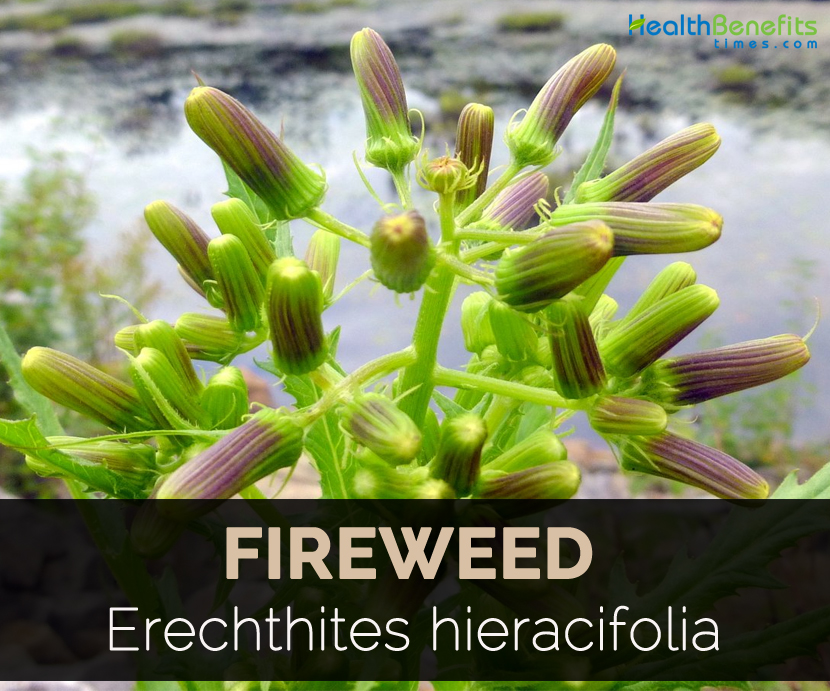| Fireweed Quick Facts | |
|---|---|
| Name: | Fireweed |
| Scientific Name: | Erechthites hieracifolia |
Plant description
It has herbaceous annual, 50-100 cm tall. Leaves are opposite and larger at the base and smaller and alternate towards the top. Leaves are deeply divided to slightly lobed. Both leaves are covered in white hairs. Flowers are clustered together. They form a dense and flat cluster of small flowers or florets. Florets are numerous and yellowish-purple or mauve. Lowest leaves are petiolate, ovate-lanceolate to lanceolate and entire or serrate to irregularly dentate. Inflorescences are terminal and axillary. Capitula is slender at anthesis about 10 mm long and 3 mm wide. Disc florets are more numerous than marginal. Achene is cylindric, about 2.5 to 3.5 mm long with heavy and pale brown ribs, dark brown and entirely glabrous to minutely villous or hispidulous in the grooves. Flower heads are yellow or pink and borne in fall. Heads are followed by cluster of small and wispy achenes. Inner bracts are often with purplish tips and form a ½ inch tube exposing just yellowish to creamy white stamens at the top.
Leaves
Leaves are crisp and fragile, 8 inches long and 3 inches wide and lower ones are broad lance shaped, tapered to a short stalk and shallow to deeply lobed with jagged teeth around the edges. It is sparsely hairy on underside along the midrib, becoming smaller and stalkless or clasping. Stems are brittle and erect, round with vertical ridges, smooth or with sparse spreading hairs.
Inflorescence
Flowers are cylindrical about 10 mm long and 4 mm wide. Generally thickhead grows from spring to fall north and central Florida and year round in South Florida. Flowers produce 91 to 150 seeds producing 750-1150 seeds per plant.
Uses
As a prompt botanical in purifying the system in diseases of the blood, and discharges of bloody flux. Administered either in a strong decoction, or the alcoholic extract. It is unrivalled in accumulation of excess mucus and the many progressive disease symptoms this condition brings on. To mention a few: the common cold, allergies, hay fever, tonsilitis, cholera, dysentery, haemorrhoids, etc. It is strongly astringent and will quickly relieve pain due to its influence in arresting the discharges and effectively diminishing unwanted accumulation. It is invariably successful in summer complaints of. children, even in cases where other means have failed.
Dose: Steep 1 heaped teaspoonful of the root and herb in 1 cup of boiling water for ½ hr. Prompt relief will follow when taken hot in small amounts, often. Of the tincture, ½-1 ft. dram as called for.
Homoeopathic Clinical: Tincture of whole fresh plant—Diarrhoea, Gonorrhoea, Haemorrhage, Metrorrhagia, Orchitis.
Medicinal uses
- It helps to improve appetite and digestion.
- It is helpful for constipation and flatulence.
- Tea made from roots and inside parts of stem is used to help with constipation.
- Rub the dried inner stem and powdered to hands and face in the winter to protect the skin from cold.
- Native Americans and Europeans use fresh juice of fireweed to soothe skin irritations and burns.
- It is used to manage fever, gout, sciatica and rheumatism.
Culinary uses
Foliage and young tops are consumed as salad and potherb.
References:
https://en.wikipedia.org/wiki/Erechtites_hieraciifolius
https://www.minnesotawildflowers.info/flower/pilewort
https://www.henriettes-herb.com/eclectic/kings/erechtites.html
http://sandyhookherbarium.org/erechtites-hieracifolia-american-burnweed/
https://galileo.org/kainai/fireweed/
https://livingenergy.ca/?p=901
Comments
comments
